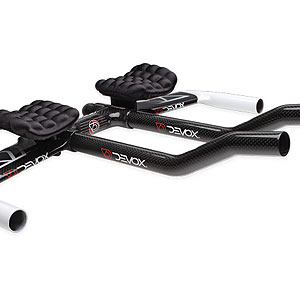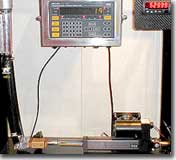Must house brands perform?

For 2009, to a degree not apparent in former years, Felt's component house brand has blossomed. Fourteen years ago Trek Bontragered itself and, now, Felt has Devoxed.
The comforting thing about it, from Felt's point of view, there is no Devox person. Trek sidles up to people—Gary Fisher and Keith Bontrager, for example—and sometimes those partnerships are sparkling, while sometimes they don't go as well as they might; I mean, there's the performance of your brand, and the performance of the person whose name is on your brand: twice as many opportunities for things to go well or poorly.
There is no such person as Bob Devox. At least, not that I know of. This can be handy. What if Felt's component line was named Vick, in honor of a partnership with an athlete? How might that've turned out?
On the other hand, Gary Fisher has actually been referenced in a novel, for cripesakes, so sometimes that gamble pays off. What if Keith Bontrager brokers peace in the Congo, or lands a plane on the Hudson? Bob Devox can't do that.
So there is no personality to whom Felt has hitched its wagon—except, of course, Jim Felt, and I have it on good authority he's not a dog fighter—and we instead have Devox. It's now all on Felt's engineers, designers, and marketers (we'll call them, in the aggregate, Bob Devox) to design and source adroitly, or poorly.
I write all this because I'd like to talk about house brand components in general, and saddles and aero bars in particular. Felt is gambling. As far as saddles go, who cares? It seems every brand has its $5 or $10 house-brand saddles made, usually by one of two factories in Taiwan, and it's an elegant way to escape the scrutiny of putting a known low-priced saddle on a high-priced bike. From a product manager's point of view, it's expensive to spec a Selle Italia SLR or a Fizik Arione as original equipment. But you don't want to spec something really cheesy, for fear of customer blowback. So you spec a house-brand saddle, the value of which can't be easily found out. Many brands do this.
But I don't sense that's what Felt is doing with its saddles. I think they're reaching a bit higher. I think they're actually trying to be a manufacturer of saddles, straight up, in the way that Specialized is trying to do it with its Body Geometry line (and to a large degree succeeding).
Then there are the Devox aerobars. That's ambitious. Is Felt ready to be an aerobar maker? That is, is Felt just trying to save money on aerobars in the same way companies try to save money on saddles, or is Felt really trying to be an aerobar company?
Time will tell. I think (I do not know, because I haven't ridden them) that I like the higher-end Devox TT/Tri bar (pictured above). It's got all the requisite elements: two extension positions (depending on how you cut the extensions), adjustable-length extensions, reasonably plush looking armrests; an appealing design; light weight; appropriate looking spatial relationships between armrests, extensions and pursuit positions.
But there are some issues. First, the carbon bar is built to accept a 26.0mm stem clamp. Regardless of what you think of 31.8mm, it's harder and harder to find a 26.0mm stem these days, and the aerobar either needs to accept, or to be built in a version that accepts, 31.8mm stems.
Second, the specs on these bars are not easily discoverable. Are the extensions the industry standard 22.2mm O.D.? Yes, they are, but it took me the better part of a day to find out. This needs to be obvious and findable, so that a customer can determine whether these $900 aerobars will or won't accept other companies' extensions, or SaltSticks. There is no listing at all on Felt's website showing Felt's lesser expensive aerobar, for its more entry-priced bikes. No photos. No specs.
Felt's accessories need to be ready for prime time, and in large margin they are. But as it has brought its products to market, the effort to show and explain these products to its customers lags a bit. If Felt—and Trek with Bontrager, for that matter—wants to fashion itself an aerobar company, it needs to do everything an aerobar company does.
Finally, the aftermarket prices can't be phantom values. If Felt specs a $900 Devox aerobar, and Trek a $900 Bontrager wheelset, on their bikes, the implication is that these Felt and Trek models spec $900 widgets, while the competition specs, perhaps, a $400 widget on their models. It's a gamble. Customers aren't stupid. If the house brand products don't sell, in the standalone aftermarket, in reasonable quantities at those stated MSRPs, then these valuations are fictitious.
There are two models for how bike manufacturers do business. First is the old-school European model, and we'll use Italians as an example. There were frameset makers, like Colnago and Bianchi. There were component makers, most obviously Campagnolo. There were frame sub-assembly makers like Columbus. Handlebar and stem makers like Modolo, 3T and Cinelli. Saddle makers like Selle Italia, Selle San Marco, Selle Royal. Tire companies like Clement and Vittoria. Rim makers like Ambrosio and Fiamme.
All these companies helped to set industry standards, and made parts that worked in concert with the standards set by others (much like Isis and BB30 today). They were all strategic partners, and each relied on the other to perform the design and engineering required. This reliance on a family of manufacturers provided a safety net. Was there chance of a weak link in the design and engineering chain? It's a question reasonable industry people can debate.
Trek, Specialized, Cannondale, and increasingly Felt and others, want to operate more the way of motorcycle companies. No, they don't want to own saddle factories, but they increasingly want a bicycle to be sold according to a motorcycle paradigm. Few ask what saddle comes on a Honda or a Kawasaki—what handlebars, headlights, or engine, or footpegs. Wouldn't it be convenient if bikes were sold that way? Yes, if you're the manufacturer, because you can control the engineering; you can more easily control the price; and you can keep your bicycle from being compared based on spec instead of based on your frame innovation (it was not that long ago that a frequent sort of question might be: "What is your cheapest Ultegra bike?").
I do not know if—when I was a manufacturer—I was the first to just start spec'ing "no pedals." Pretty much every other brand, if you go back 18 or 20 years, put cheap clip-and-strap pedals on its bikes, which everyone knew would be immediately pulled off in favor of a clipless pedal. "Why the ruse?" I thought. Why not just ship the bike with no pedals?
I bring this up, because I'm of the mind that nowadays bikes should be shipped with no saddles. Just let the retailer stick the saddle on of his choice for show, and let the customer choose his saddle of choice for dough. This moves the ball forward, in most cases, because this forces customers to consider the question of, "Which saddle is best for me?" rather than lazily and ignorantly going with the OEM house brand saddle.
When I see a house brand saddle on a bike, I'm increasingly jaded, and it does not reflect well on the bike maker. Let us just stop it. If you put your name on it, by god it better be worthy of your brand's name, otherwise just put a brand on the bike that stands on its own. Or—in the case of saddles—if you can't afford to spec something worthy of your frame, just don't spec a saddle at all. Believe me, retailers have plenty of good saddles to put on your bike. If you're afraid of what saddles dealers might stick on your bike, then make high-quality saddles a display requirement in your dealer agreements.
If Felt, or Specialized, or Trek, or Cannondale, wants to be in the parts game—if they want Body Geometry, Hollowgram, Devox, Bontrager to have the same cache as Hed, Zipp, Shimano, Campagnolo, Easton, SRAM—they must earn it engineer by engineer; designer by designer; tech brochure by tech brochure; customer service by customer service. They must treat these component companies as separate stand-alone companies, with their own staff, their own profit-and-loss, their own websites and trade show booths; their own management.
Otherwise, even the most well-meaning efforts—like Trek's Matrix and Cannondale's Coda—will not catch hold. They must be well-funded, autonomous house brand efforts, or they are destined to recede in image and value.
This isn't to say that the big bike companies ought to stick the Italian model. No, rather I'll exhort them to go all the way in their efforts. Specialized must not make Body Geometry saddles as alternative to Fizik. Specialized must be Fizik, in every meaningful way. Bontrager, the wheel company, must do everything Mavic does, as well as Mavic does it, in those product categories and price points in which Bontrager chooses to compete. And Felt's new aerobar—which I must say has gotten very good reviews from many of its dealers to whom I've spoken—must commit to the same effort to market, perform customer service, engineer, tool and design—that Profile Design commits to.
So, Bob Devox, keep working evenings and weekends designing quality parts for Felt's excellent bikes.



Start the discussion at slowtwitch.northend.network